|
All done for the Fed?
|
 |
June 5, 2000: 2:52 p.m. ET
Wall St. believes the Fed has slowed the economy; the Fed may not agree
By Staff Writer M. Corey Goldman
|
NEW YORK (CNNfn) - Last month, when the Federal Reserve raised interest rates by a half-point, almost every major Wall Street dealer was calling for an encore. The economy is too strong, they said. The labor market is too tight. People are spending too much money. Prices are starting to rise.
What a difference a few weeks and a sharp downturn in job creation make.
Wall Street let out a big whoopin' holler of joy last Friday after the government reported that hiring among private companies declined in May, the first monthly drop in more than four years. The pace of job creation, or in last month's case, job elimination, was the swiftest in more than eight years.
You could almost hear the champagne corks popping as traders celebrated the unexpected gain in the ranks of America's unemployed. Finally, the Fed's six rate increases that have driven borrowing costs almost 2 percent higher in less than a year were beginning to make companies think twice about hiring, they said. Finally, some sobering reality for the 'dot.bomb' start-ups.
And sure enough, one after another of Wall Street's major dealers -- the big guns that buy and sell huge blocks of stock, lots of Treasury debt and the players everyone listens to when it comes to market predictions -- called off the guards. Goldman, Salomon, Merrill... many of the big players' head economic honchos went public, making clear that they believe the Fed is now on hold.
Keep the champagne on ice
But is it really mission accomplished for the Fed?
"The employment numbers easily give the Fed reason to pause, but it doesn't necessarily mean they are finished with raising rates," said Alan Blinder, a fellow with the Brookings Institution in Washington and former vice chairman of the Fed. "They will want to see more evidence of slowing, both in the employment numbers and in other areas of the economy."
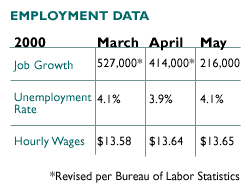 Blinder, who sat in the No. 2 spot beside Chairman Alan Greenspan from June 1994 through January 1996, pointed out that the policy gurus who sit on the Fed's Open Market Committee likely will want to see what their handiwork has done to the progress of the economy, now in its ninth year of uninterrupted expansion, before raising rates again. Blinder, who sat in the No. 2 spot beside Chairman Alan Greenspan from June 1994 through January 1996, pointed out that the policy gurus who sit on the Fed's Open Market Committee likely will want to see what their handiwork has done to the progress of the economy, now in its ninth year of uninterrupted expansion, before raising rates again.
But that doesn't mean they won't move again at their upcoming meeting June 27-28 "as a little insurance measure," he said. "They could easily adopt a wait-and-see approach and examine more of the economic data as it comes in, but I doubt highly that anyone who sits at that table is convinced right now that their job is done," he said.
Indeed, while there is certainly economic evidence indicating the economy is responding to the Fed's rate increases -- faltering job growth, slower manufacturing output, stagnating wages, subdued spending, lackluster retail sales and slowing home sales -- the evidence, at least for the moment, is still more of a mole hill than a mountain.
Slowing, yes, but from 240 mph
"There is no question that the economy is slowing, but it's not exactly shrinking, either," said Michael Gregory, vice president and chief economist with Lehman Brothers Inc. "We are seeing the first tentative signs of slowing, but you have to remember that we are starting at a very high base of growth. The Fed will still err on the side of caution and restraint."
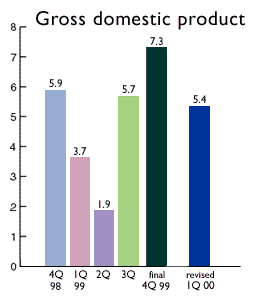 The U.S. economy advanced at a 7.3 percent pace in the fourth quarter of 1999, then slowed slightly to a 5.4 pace in the first quarter, according to revised figures released by the Commerce Department last month. The U.S. economy advanced at a 7.3 percent pace in the fourth quarter of 1999, then slowed slightly to a 5.4 pace in the first quarter, according to revised figures released by the Commerce Department last month.
Gregory also noted that the markets' reaction to Friday's news in itself could lead the Fed to stay in the proverbial ring for another round. Why?
For one, the triple-digit gains in both technology and blue chip stocks likely will rekindle concern about the wealth effect, in which rising stock values make Americans feel good about spending money. While nowhere near the levels seen at the beginning of the year when both the Dow and Nasdaq hit record highs, at least part of the paper wealth shed by the recent downturn has recovered, leaving people's portfolios looking a little less sickly.
What's more, falling government bond yields and the declining value of the U.S. dollar against other major currencies -- a direct result of investor expectations that official rates won't rise any higher -- also may spur the Fed to take action. On the bond side, lower yields encourage businesses to borrow at cheaper rates, fueling inflation. On the dollar side, a weaker currency encourages international buyers to stock up on U.S.-made goods.
Time is not on the Fed's side
And, Gregory said, time may not necessarily be on Greenspan & Co.'s side. With about two months between the June meeting and the August meeting, "the Fed is going to want to take the more cautious road. Two months is an awful long time to wait to react to evidence, particularly if that evidence indicates the economy is starting to heat up again."
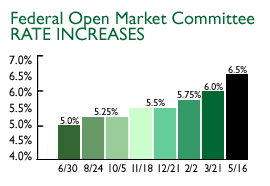 Gregory is predicting the FOMC will raise rates by a quarter point at their end-of-month meeting as an "insurance move," and he's undecided about whether or not they will raise rates again in August. The Fed last raised its benchmark fed funds rate by a half point to 6.5 percent May 16, the first half-point move in more than five years. Gregory is predicting the FOMC will raise rates by a quarter point at their end-of-month meeting as an "insurance move," and he's undecided about whether or not they will raise rates again in August. The Fed last raised its benchmark fed funds rate by a half point to 6.5 percent May 16, the first half-point move in more than five years.
There are, of course, compelling reasons for Greenspan and the other policy makers to leave the economy alone and begin their summer holidays a little early rather than sticking it out and delivering more harsh medicine to Main Street and Wall Street.
With the exception of a one-month surge in March, inflation has remained extraordinarily tame. Consumer prices in April rose at a 3 percent pace from a year earlier and were unchanged from March. And productivity, which rose at a 2.4 percent pace in the first quarter of the year, still is expected to offset any increases in costs for businesses, ensuring that inflation remains benign.
A little too zealous, perhaps?
That has a large percentage of analysts on Wall Street and a growing number of people on Main Street wondering if perhaps the Fed hasn't already gone too far in its zeal to keep inflation at bay.
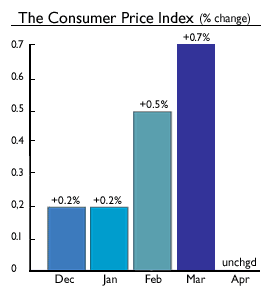 A rate move from the Fed typically takes six to nine months to filter its way into the system and have an impact on the economy by altering the cost of borrowing for consumers and businesses and changing spending patterns. A rate move from the Fed typically takes six to nine months to filter its way into the system and have an impact on the economy by altering the cost of borrowing for consumers and businesses and changing spending patterns.
That means the Fed's first rate increases back in June and August 1999 are only now beginning to have an impact on growth, and the other four still haven't fully made their way down the pipeline, according to economists.
In addition, Fed officials have tried to telegraph in very clear terms to the investing public that, while they are carefully watching how stock values affect the economy, they are not directly targeting stock values with their monetary policy. That should mean that the recent rebound in stock values, most notably the dramatic jump in the Nasdaq, should have no bearing on the Fed's decision-making process.
"After being worried that the economy was too hot and that inflation was coming back, suddenly you have this notion that maybe the economy is a little soft, that maybe the Fed has been a little overzealous," said Kevin Bannon, chief investment strategist with Bank of New York.
Still work to be done
From an investing point of view, that means tread cautiously, Bannon said. Investors who focus on companies that have strong growth and earnings potential in sectors such as banking, technology and biotech should be able to achieve positive returns no matter what the Fed does in the months ahead. (468KB WAV) (468KB AIFF)
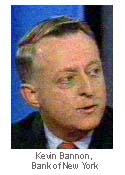 According to a Reuters poll conducted Friday, most economists believe the Fed's next move will be no move. Of the 29 banks and securities firms that directly trade Treasury securities with the Fed, 24 said they now expect the FOMC to hold rates steady at the end of this month. According to a Reuters poll conducted Friday, most economists believe the Fed's next move will be no move. Of the 29 banks and securities firms that directly trade Treasury securities with the Fed, 24 said they now expect the FOMC to hold rates steady at the end of this month.
That sentiment is reflected in fed funds futures contracts, a gauge of investor expectations about the outcome of the Fed's interest-rate actions in coming months. The yield on the July fed funds futures contract currently is at 6.60 percent, just 10 basis points above the current 6.50 fed funds rate, compared with 6.75 percent a week ago. That suggests investors now are pricing in about a 40 percent chance of a fed move at the end of June.
No doubt, not everyone on Wall Street believes the Fed has overdone its work, nor do they believe the Fed is finished with tugging on the reins.
"Is there a risk the Fed has tightened too much? Not with the kind of momentum we're seeing in the economy and not with consumer confidence at record highs," Lehman's Gregory said. "People are wealthier, real incomes are growing, the housing market, while slower, is still super strong and the labor market is still super tight. I don't think the Fed is finished just yet." 
|
|
|
|
|
 |

|

